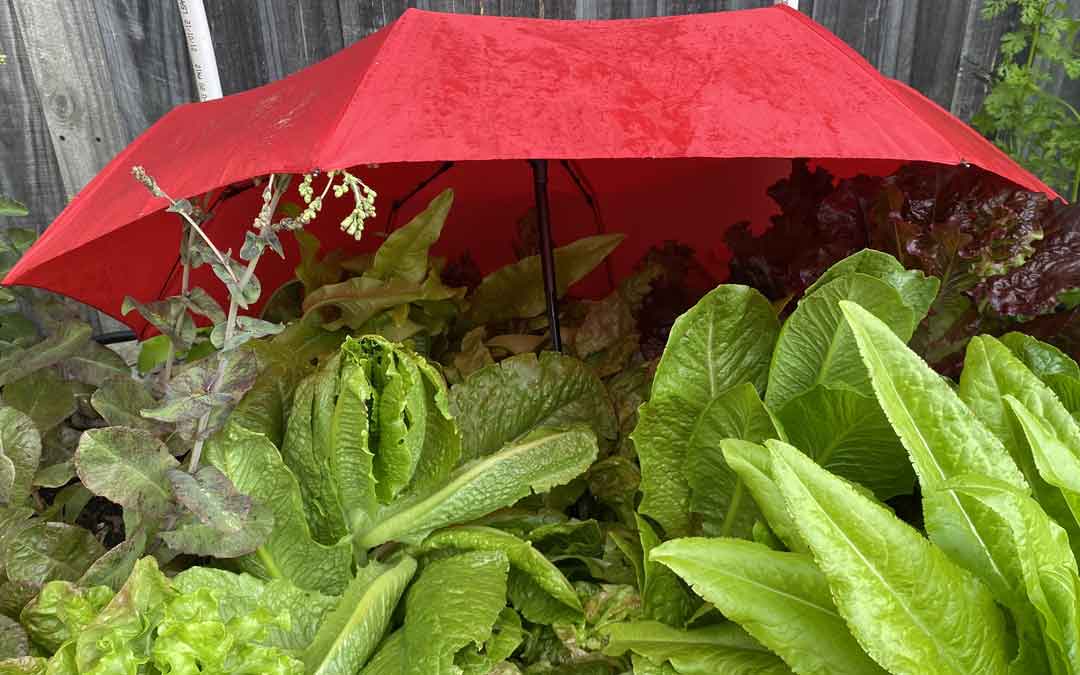Beat the heat wave with quick, easy and temporary shade structures

When the temperature soars, it’s time to shade our fruit and vegies, but how? We can build permanent structures that come at a hefty price and will be permanent, but that may not suit our garden year-round or our pocket. Here’s some tips on using what you have or perhaps can borrow, and on turning other people’s rubbish into useful items.
Umbrellas – standard umbrellas, golf umbrellas and beach umbrellas (the bigger the better) are all useful. Smaller ones can be inserted into the ground, handle and all. Cover the handle with a plastic bag if you want to keep it clean. Larger ones can be angled with one side on the ground in the direction of the sun (as you might at the beach) and a couple of bricks placed on the pole to keep it in place or inserted into a heavy umbrella base.
Gazebos – use your own if you have one or borrow from friends. These are generally large enough to cover a 3m x 3m area.
Frames – old gazebo frames or tent frames covered with shade cloth or old sheets are a great way to recycle frames whose covers have ‘died’.
Star pickets with yellow caps – hammer one in at each corner of your bed, cover with shade cloth and secure with the yellow caps. Caps can be bought at hardware stores for about $1 each.
Shade cloth and clips – clip shade cloth to guttering with bulldog clips, roll it out and attach to a fence and clip or nail into place, or even just drape it and place a few bricks on the end on the ground.
Sheets – simply drape sheets over vegies, bushes or tree tops. Useful if it’s not windy.
For a temporary solution don’t worry about the grade of shade cloth. Vegies and fruit prefer shade cloth that blocks 30% of the light, but 60% won’t do any harm for a few days.
Watering and shading are the keys to fruit and vegie health in heat waves.
Watering is essential. Begin watering your plants deeply for days before the high temperatures arrive and water in the morning and evening if necessary during the heat wave and for a few days afterward. Make sure you water the soil, not the leaves. Dig into the soil to check the water is penetrating. A well-hydrated plant will never wilt or scorch. Both wilting and scorching indicate a lack of hydration.
Shading does two things. It slows down the drying out of soil and it prevents sunburn of fruit and vegies. Just as we can get sunburnt, so can our tomatoes, capsicums, eggplants, apricots, peaches, nectarines and other fruit and vegies. Good hydration will not prevent sunburn. Think of it this way: we could be fully hydrated but if we are out in the sun without protection we’ll burn and blister. So too, our fruit and vegies!
High temperatures and heat waves sadly are here to stay and something gardeners need to prepare for in advance. Now is the time to find equipment to do the job. Ask family, friends and neighbours to give you items that may be heading to hard rubbish.You’ll be helping them out, preventing more waste going to landfill and protecting your produce at the same time. That’s a win, win for everyone!
Shade cloth-need, purpose and options
Written by Robin Gale-Baker
